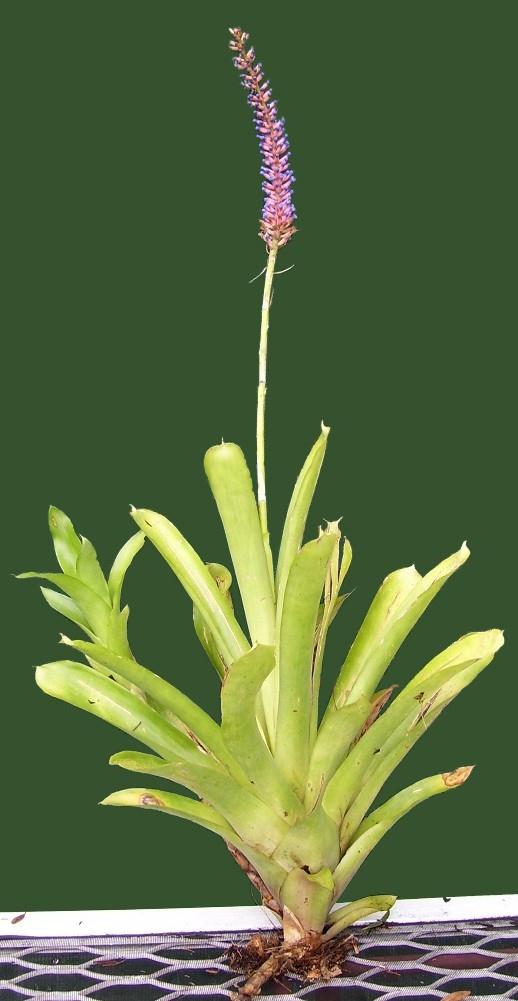

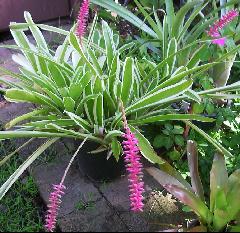


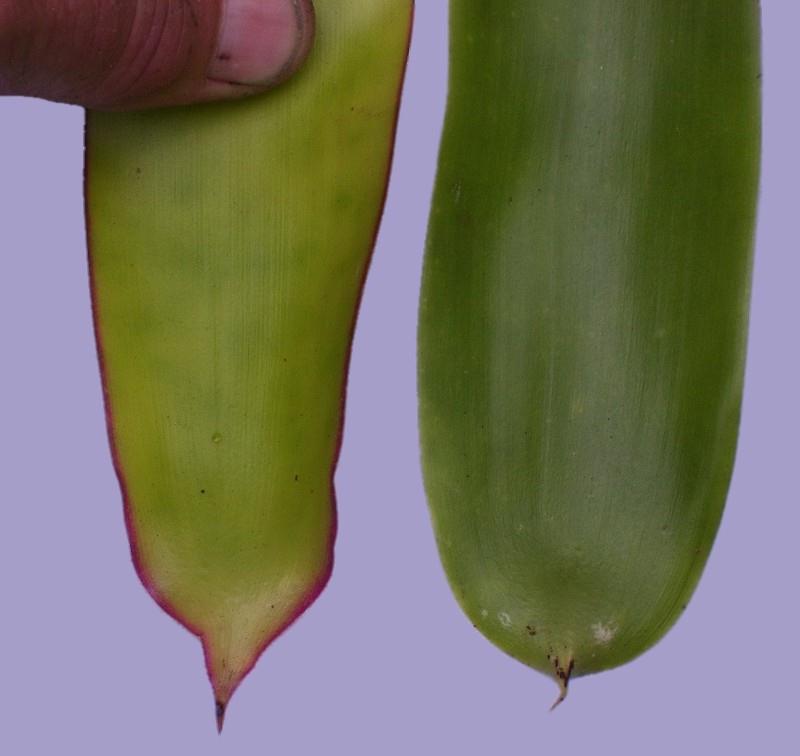
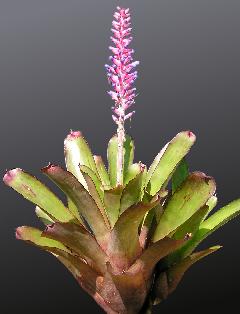
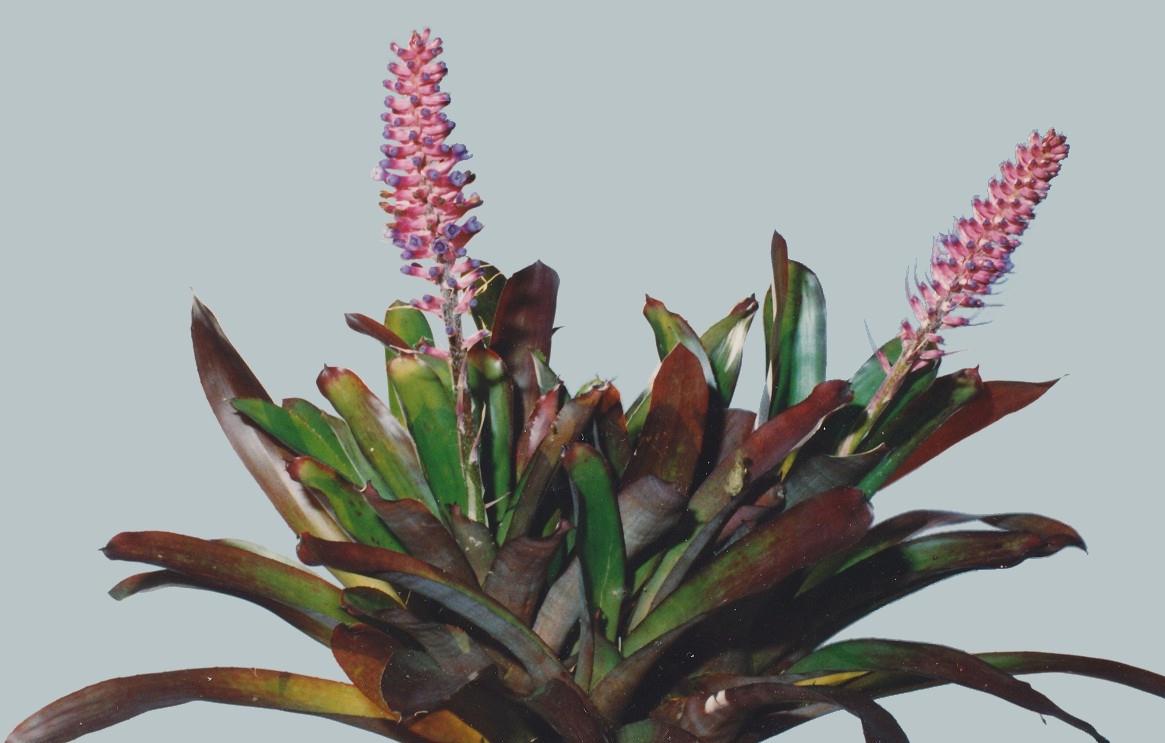
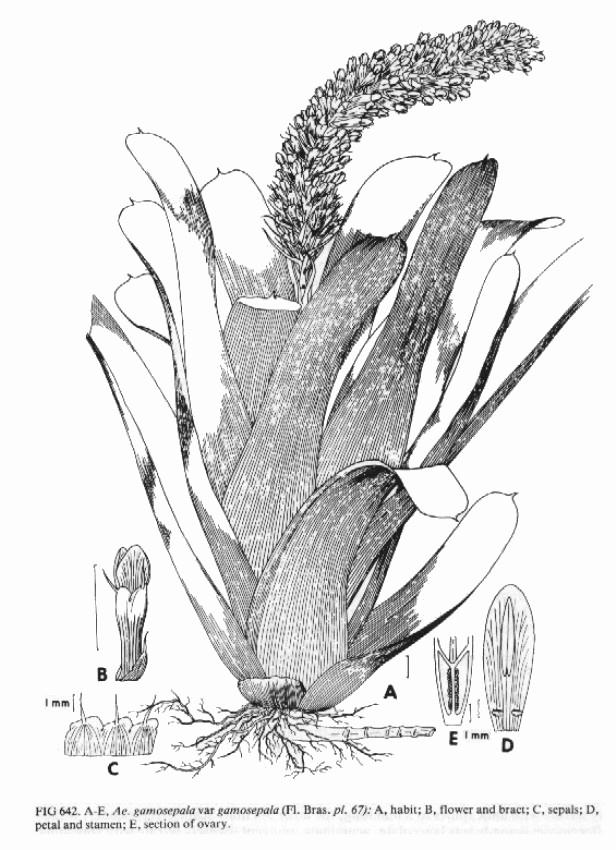
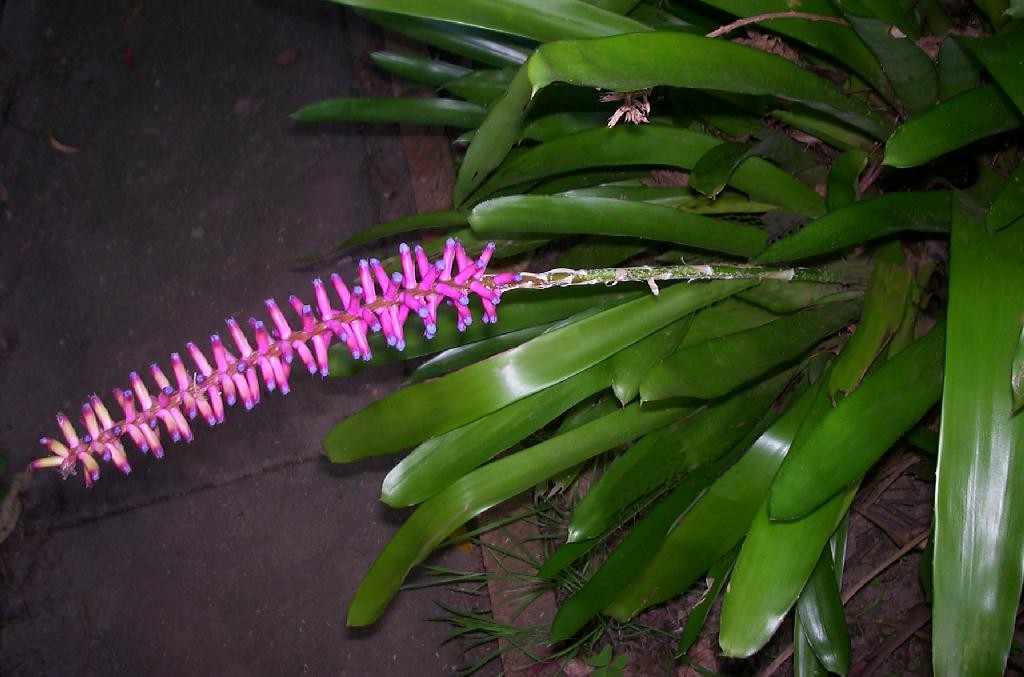
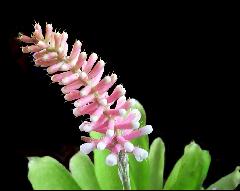
I have been acquainted with this species for at least the last 30 years so why the sudden interest. Recent activity on a Bromeliad Forum, show that this plant is still being grown, and is still popular. Renewed interest in setting up a Gamosepala Group on the Bromeliad Cultivar Register has prompted me to go into print. If you are in the BCR data base on http://botu07.bio.uu.nl/bcg/bcr/index.php all you need to do is enter Gamosepala Group in the ‘Notes’ section when you do an Advanced Search. This will give you a list of what we consider is close to the species – some hybrids and some just cultivars of the species.
I have always had difficulty in reconciling the drawing in Smith & Downs with what we grow as A. gamosepala. The drawing appeared in 1892 and while the flowers may be called lax you cannot easily discern the matchstick flowers that are much further apart these days! I had always tried to identify an A. gamosepala from an A. cylindrata by the fact that A. cylindrata had a much denser inflorescence. Alas, this method does not work if we use the key in Smith & Downs which reads as follows:
18. Inflorescence with its axis slightly exposed, many-flowered.
- - - 20. Flowers 20 mm long; inflorescence stout; floral bracts soft. . . . . . cylindrata
- - - 20. Flowers 15 mm long; inflorescence slender; floral bracts pungent. . . .gamosepala
You have to decide if the floral bract which is the insignificant papery thing immediately below each flower, is soft or sharp!
But when we read Reitz in his Flora Illustrada Catarinensis 1983 we find that petals can be 20mm long for A. gamosepala. We must remember that Santa Catarina is where the type specimen was found but not seen by Smith. Another thing missing in the Smith & Downs description is that A. gamosepala is stoloniferous – some with short stolons, some long. The following is what we should be using for identification
Description from Smith & Downs
Plant flowering 40-75 cm high. (stoloniferous)
Leaves 15-20 in a dense funnelform rosette, 25-55 cm long, covered with pale minute appressed scales especially beneath, nearly entire or with a few minute spines near apex; Sheaths narrow but distinct, sometimes tinged with blue;
Blades ligulate, broadly rounded and apiculate, 3-5 cm wide.
Scape erect, slender, sparsely white-flocculose, soon glabrous;
Scape-bracts erect, lanceolate or elliptic, acute, entire, membranaceous, deciduous. Inflorescence simple, slenderly cylindric, obtuse, sublax, 9-26 cm long; rhachis slender, glabrous or nearly so.
Floral bracts narrowly triangular, attenuate, pungent, entire, nerved, the lower exceeding the flowers, the upper shorter than the ovary;
Flowers sessile, spreading or suberect, 15 mm long.(20mm long)
Sepals strongly asymmetric, rounded, 4-5 mm long without the 2.5-4 mm spine, half-connate, glabrous;
Petals erect, ligulate, obtuse, 9 mm long, purple or blue, bearing 2 fimbriate scales near base;
Stamens included;
Ovary slender, narrowed toward base; epigynous tube large, crateriform; placentae central; ovules obtuse.
Distribution. From terrestrial on dune slopes to epiphytic in forest, from near sea level to 250m alt, Sao Paulo to Rio Grande do Sul, Brazil.
Sepals rose; petals white.
Type. Reitz & Klein 9093 (holotype, HBR), terrestrial in woods, Pirao Frio, Sombrio, 10m alt, Santa Catarina, Brazil, 5 Sep 1954.
Distribution. Known from the type collection only.
This renewed interest caused Australian growers to look at plants they had been growing for years and there were definite forms being grown that were different to the ‘norm’, one with long stolons – generally called ‘with stolons’, and another with reddish leaves called ‘Rubra’.
Recently we have seen registered
1. Aechmea ‘Big Pinkie’
A large form of gamosepala named by Ross Little, NSW. Origin unknown. Fertile part of inflorescence to 35cm long. No apparent stolons.
2. Aechmea ‘Ruby Red’,
named by Ross Little, NSW, for a plant that has been circulating Australia for over 20 years as A. gamosepala Rubra. Grown at least by Ruby Ryde and Nina Rehak in Sydney and Bernard Stonor in WA. Leaves redder, wider and stiffer than the ‘normal’ A. gamosepala. Plant to 30cm high, to 60cm when in flower.
3. Aechmea ‘Big Matchsticks’
named by Geoff Lawn, WA, Mature rosette to 50cms. diameter x 60cms. high. Erect spike to 1 metre tall. Lengthy stolons to 50cms. Flowers are paler than "normal" gamosepala. This clone has been circulating in Australia for over 20 years as "gamosepala big form", or “With stolons”
4. Aechmea ‘Red Lips’
Named by Ross Little, NSW. A form of A. gamosepala with red leaf edges. Grown for many years at Pinegrove Nursery as just another A. gamosepala but differs in several ways. Plant smaller than ‘Big Matchsticks’ but still with stolons. The scape is reddish and the fertile part of the inflorescence somewhat disappointing at only around 13cm long and 3 cm wide.
We know that ‘lots’ of gardeners grow Aechmea gamosepala even if they don’t know the name! So if the keen ones amongst you who look for differences happen to come across some unnamed plant which flowers like A. gamosepala remember that they come with different names for the different forms. If you come across yet another form please let me know.










